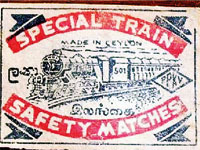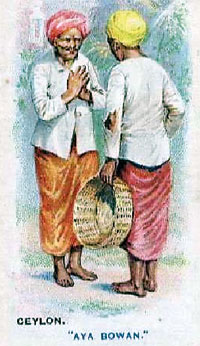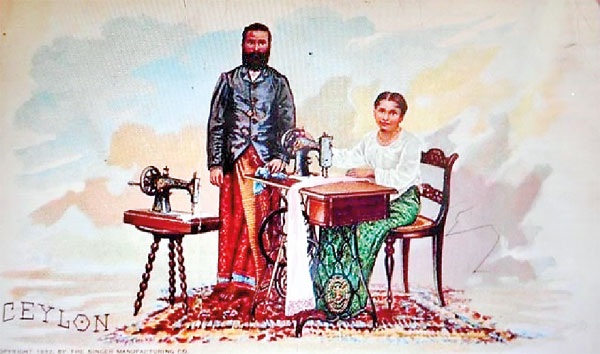Collecting Ceylon
View(s): Royston Ellis delves into the stories behind the labels among his old curios
Royston Ellis delves into the stories behind the labels among his old curios
As an impulsive collector of unusual items associated with this country, I have many curiosities in my collection, from a coconut scraper made from the frontal bone of an elephant’s skull to rare maps over 400 years old.
Since Ceylon ceased to exist as the name of this country over 40 years ago, any item produced before 1972 and bearing the word “Ceylon” is bound to have a certain value for collectors. Obvious small items for the collector of Ceylon memorabilia or ephemera are postage stamps and postcards,which are still easy to find either through online auctions or local antique shops.
I like to collect items that are not so easy to find, and these are often more interesting because of what they reveal of bygone times. Matchbox labels fall into this category and a collector in the UK published a 60-page catalogue in 1981 about the labels on matchboxes produced in Ceylon. It lists over 20 manufacturers in Colombo, Jaffna and Galle.
 Inspired by the labels in my collection to delve deeper, I discovered that the production of safety matches was one of Sri Lanka’s earliest private sector industrial enterprises.In 1936 a proposal was passed by the State Council to set up a licensing and quota system to protect the industry. This led to G.G. Ponnambalam stating during the debate that: “The quality of matches is so poor… people would like to have matches imported from outside.” Forty years later, Mallory Wijesinghe, a former chairman of the Ceylon Chamber of Commerce, observed: “In Sri Lanka everything strikes except the matches.”
Inspired by the labels in my collection to delve deeper, I discovered that the production of safety matches was one of Sri Lanka’s earliest private sector industrial enterprises.In 1936 a proposal was passed by the State Council to set up a licensing and quota system to protect the industry. This led to G.G. Ponnambalam stating during the debate that: “The quality of matches is so poor… people would like to have matches imported from outside.” Forty years later, Mallory Wijesinghe, a former chairman of the Ceylon Chamber of Commerce, observed: “In Sri Lanka everything strikes except the matches.”
A collector of matchbox labels is known as a Phillumenist. I acquired my first match box label in pursuit of unusual items connected with the railways of Sri Lanka. This is a matchbox label bearing the phrase “Made in Ceylon” and depicting a steam locomotive and carriages. Plainly shown is its Number: 501. Captions are in Sinhala, Tamil and English with the logo PPKV.
I wondered if this reference to KV referred to the Narrow Gauge KV (Kelani Valley) Line. From the catalogue, however, I see that the cypher was the trademark of P.P.K. Vellaippa, the manufacturer coincidentally based in Kelania. When I consulted my books on railways to see if I could identify the year this steam engine was built, I discovered that the number 501 was given to the first diesel power set imported in 1938 and named Silver Foam. It ran on the west coast line between Colombo and Galle until being scrapped in 1955.
To add to the mystery, the numbering of steam locomotives in Sri Lanka didn’t go beyond 362 when the last steam locomotive was delivered in 1951. So what is this engine depicted on the matchbox cover – a figment of an artist’s imagination or a real steam loco?
 Thanks to the diligence of a compiler who has posted a list of steam engines on the internet, I discovered a locomotive that might be the original for this match box design – but in Burma not Ceylon. It’s Number 501, Class YB, 4-6-2 wheel, metre gauge, made by Vulcan Foundry at Newton-le-Willows, England.Vinodh Wickremeratne, the indefatigable expert on Sri Lanka Railways, informs me that: “the overall silhouette is as a smaller scaled version of the Flying Scotsman.”
Thanks to the diligence of a compiler who has posted a list of steam engines on the internet, I discovered a locomotive that might be the original for this match box design – but in Burma not Ceylon. It’s Number 501, Class YB, 4-6-2 wheel, metre gauge, made by Vulcan Foundry at Newton-le-Willows, England.Vinodh Wickremeratne, the indefatigable expert on Sri Lanka Railways, informs me that: “the overall silhouette is as a smaller scaled version of the Flying Scotsman.”
I am also a labologist, the name for a collector of beer labels. One label in my collection is from The Ceylon Brewery “Light Beer” produced in NuwaraEliya. Fortunately, the label bears a contemporary storekeeper’s date stamp, showing it is 75 years old, having been issued on 24 February 1941. The Ceylon Brewery sprung out of a cottage industry started by Sir Samuel Baker in 1849 in Nuwara Eliya which, with its natural spring water and cool climate, was ideal for beer brewing. Beer was produced for local consumption, much to the delight of resident British planters, until the brewery was established as a commercial operation in 1881. Its product range expanded in 1940.
Since I also collect cigarette cards, I can call myself a Cartopholist. These are the small cards that were first introduced in 1875 to be given away with packets of cigarettes. Each card that I have tells a story not just in the text but also in its artistic style. That’s evident from one card in my collection that shows an almost pastoral view of Colombo when it had lots of green spaces and was known as the Garden City of the East. Another fascinating card depicts the greeting “Ayubowan” between two men. The information on the back states: “If the salutation is to a superior the hands are held in front of the forehead and the head is bent. If to an equal or inferior, the hands are held in front of the body.” An even older card (1892) shows “Singer Manufacturing Company employees in their national costume”with the comment: “The company has offices in all principle cities and sells a large number of machines.”
Those antique sewing machines are themselves collectible, another one of the many unusual items that bring the history of Sri Lanka alive.


